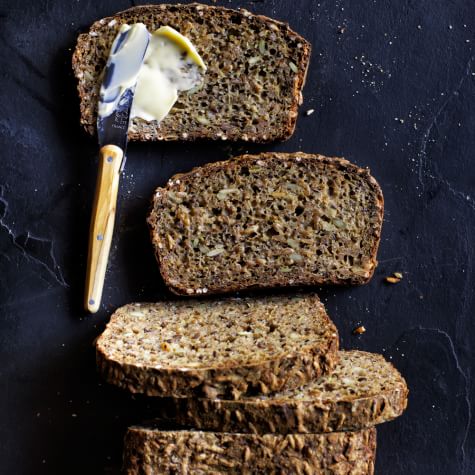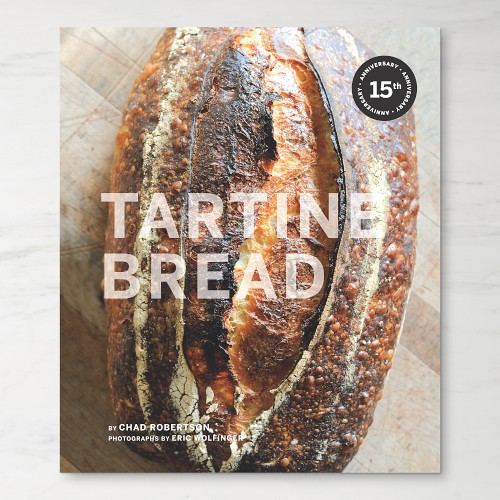
René's Rye Bread
This hearty bread from Tartine Book No. 3 is the work of master baker Chad Robertson, of San Francisco’s Tartine Bakery, who began with a base recipe that came from his Danish chef friend René Bolvig. According to Chad, “Sprouting the grain makes the bread immensely more digestible, and adds a natural sweetness from the rye berries themselves.” Because his breads rely on the precise control of the ratio of ingredients and a long rising time using a natural leaven, we have included his metric weights for each ingredient, as well as instructions for making the leaven. It’s a time-consuming process, but once the leaven is made, it can be stored for a long period in the refrigerator and later used in any of the unique breads in his beautiful cookbook.
Ingredients:
For the leaven:
- 625 g white bread flour
- 625 g whole-wheat bread flour
- 300 g slightly warm water (80° to 85°F/26° to 29°C)
For the bread:
- 400 g high-extraction spelt flour
- 100 g whole-grain dark rye flour
- 180 g buttermilk
- 135 g dark beer
- 20 g dark malt syrup
- 475 g water
- 17 g fine sea salt
- 525 g sprouted rye berries
- 45 g sunflower seeds
- 135 g whole brown flaxseeds
- 70 g coarsely ground brown flaxseeds
- 105 g unhulled brown sesame seeds
- 45 g pumpkin seeds
Directions:
To make the leaven:
To make the leaven, in a bowl, whisk together the white and whole-wheat bread flours. This is your 50/50 flour blend.
In a medium bowl, combine the 300 g warm water and 315 g of the 50/50 flour. Mix with your hand or wooden spoon to combine until the mixture is free of any dry bits. Cover the mixture with a clean, dry kitchen towel or cheesecloth and let stand at warm temperature until bubbles start to form around the sides and on the surface, about 2 days. It’s important to maintain a warm temperature. Let stand another day to allow fermentation to progress a bit. More bubbles should form. This is your starter. It will smell acidic and slightly funky. At this stage it’s time to train your starter into a leaven by feeding it fresh flour and water at regular intervals.
Transfer 75 g of the starter to a clean bowl and discard the remainder of the starter. To the 75 g of starter, add 150 g of the 50/50 flour blend and 150 g warm water (80° to 85°F/26° to 29°C). Mix to combine; it should have the consistency of pancake batter. Repeat this feeding process once every 24 hours at the same time of day, always transferring 75 g of the starter to a clean bowl and discarding the remainder, then adding the flour and water and re-covering the bowl with clean, dry kitchen towel after each feeding and letting the mixture stand at warm room temperature. The batter should start to rise and fall consistently throughout the day after a few days of feedings. As the starter develops, the smell will change from ripe and sour to sweet and pleasantly fermented, like yogurt. Once this sweet lactic character is established and the fermentation (the regular rise and fall of the batter) is predictable, a few days to 1 week, it’s time to make the leaven from this mature starter.
Two days before you want to make the bread, make the leaven, the portion of prefermented flour and water that will go into your final dough and raise the whole mass during the bulk (first) and final rises. Start feeding the matured starter twice daily, once in the morning and once in the evening, as described above, to increase the fermentation activity. When you are ready to make the dough, discard all but 1 Tbs. of the matured starter. To the remaining 1 Tbs., add 200 g of the 50/50 flour blend and 200 g warm water (80° to 85°F/26° to 29°C). This is your leaven. Cover and let rest at moderate room temperature for 4 to 6 hours.
To test the leaven’s readiness, drop a spoonful into a bowl of room temperature water. If it sinks, it is not ready and needs more time to ripen. When it floats on the surface or close to it, it’s ready to use to make the dough.
To maintain the leaven for regular use, continue feeding daily as before. To save leaven for long periods without use, add enough flour to make a dry paste and keep covered in the refrigerator. When you want to use it again, keep at warm temperature for at least 2 days and do 3 to 4 feedings to refresh and reduce the acid load that builds up while it is stored in the refrigerator.
To make the bread:
Put the spelt flour and rye flours in a large bowl. In a second large bowl, combine the buttermilk, beer, malt syrup, water and 310 g of the leaven and mix by hand to incorporate. Add the flour to the liquid-leaven mixture and mix by hand until thoroughly combined, about 5 minutes. Let the dough rest, covered, in the bowl for 30 minutes. Add the salt, sprouted rye berries, sunflower seeds, whole and ground flaxseeds, sesame seeds and pumpkin seeds and continue mixing by hand until incorporated. The dough should have the feel of wet concrete.
Cover the bowl with a clean kitchen towel and let rise at warm room temperature (80° to 85°F/26° to 29°C) for about 3 hours, giving it folds every 45 minutes to strengthen the dough. To do a fold, dip one hand in water, grab the underside of the dough, stretch it out, and fold it back over itself. Rotate the container one-quarter turn and repeat 3 or 4 times. When you are folding the dough, note its temperature to the touch and how the dough is becoming aerated and elastic.
After about 3 hours, dip your hands in water (to prevent the dough from sticking), and scoop the dough into two twice-buttered steel pans or nonstick loaf pans, each 4 by 6 inches (10 by 15 cm). Smooth the tops of the loaves with wet hands. Let rise in the pans, uncovered, for 2 hours more at warm room temperature. Cover the pans with a clean, dry kitchen towel and let rise overnight in the refrigerator.
The next day, when you’re ready to bake, use a pair of scissors to make shallow cuts in the tops of the loaves to score, brush with water and bake at 425°F (220°C) for 1 hour and 15 to 25 minutes, or until the internal temperature has reached 210°F (100°C). Due to the very high overall hydration of the dough, it’s essential to bake it thoroughly. Let cool on a wire rack for at least half a day before cutting. (The crumb is very moist, and it will be easier to slice this bread thinly if you wait until the next day to cut into the bread.) The bread will keep well for up to 1 week, properly wrapped or in a bread box. Makes 2 loaves.
Note about the sprouted rye berries: Sprouting grains is simple, and the technique is essentially the same no matter what type of grain you are sprouting. The basic method is to soak the grains in water for 4 to 6 hours. Moistening the grain activates the germination process. After soaking, the grain should be thoroughly drained and aerated by lifting and stirring with your hands—because oxygen is required for healthy sprouting to occur. Place the drained sprouts in a clean glass jar or plastic container, cover with cheesecloth, and keep at room temperature; rinse, drain and aerate the grains twice a day—once in the morning and once in the evening—returning them to the container after each washing. Most grains take 2 to 4 days to sprout depending on the room temperature; warmer is faster, cooler is slower. The grains are ready when they have just sprouted but have not yet formed spider shoots.
Once the grains sprout, they can be used immediately, kept in the refrigerator in an airtight container for a few days, or frozen for up to a week.
The volume of dry berries approximately doubles after soaking and sprouting, and on average the dry berry weight increases by 65 percent after soaking and sprouting. This means that to get the 525 g of sprouted berries you need for this recipe, you would need to start with about 320 g dry rye berries. A slight variation is not an issue, as the percentage of sprouts can be increased or decreased plus or minus 5% or more with little effect on the results.
Recipe adapted from Tartine Book No. 3: Modern, Ancient, Classic, Whole, by Chad Robertson (Chronicle Books, 2013)













